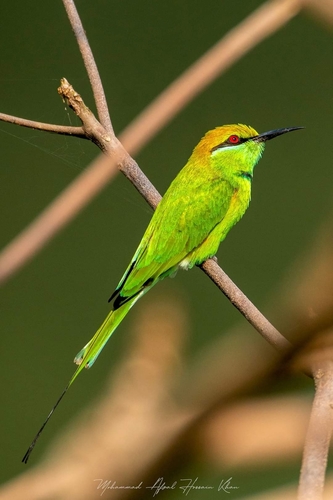
Little Green Bee-eater
The Little Green Bee-eater (*Merops orientalis*) is a vibrant and widespread species of bee-eater found across sub-Saharan Africa and Asia. It plays a crucial role in controlling insect populations, particularly bees, wasps, and other flying insects. Known for its slender build, bright green plumage, and distinctive black eye stripe, this bird is a common sight in open woodlands, grasslands, and agricultural areas. It is not currently considered globally threatened, showcasing adaptability to human-modified landscapes, though some localized populations face habitat loss.
16-18 cm
Length
29-30 cm
Wingspan
Least Concern
Conservation Status
Distribution
Sub-Saharan Africa, ranging from Senegal east to Eritrea and Ethiopia; across the Arabian Peninsula; and through much of Asia, including the Indian subcontinent, Sri Lanka, and parts of Southeast Asia (Myanmar, Thailand).
Lifespan
Unknown, but likely similar to other small bee-eater species (around 5-10 years in the wild).
Little Green Bee-eater's Habitat
Habitat Types
Open woodlands, Grasslands, Savannas, Agricultural lands, Parks and gardens, Coastal dunes
Climate Zones
Tropical, Subtropical, Arid, Semi-arid
Adaptations
Their preference for open habitats with scattered perches allows them to effectively hunt flying insects. They have also adapted to human-modified landscapes, often found near cultivated fields and villages.
Variations
Several subspecies are recognized, differing slightly in plumage coloration and size. For example, *Merops orientalis orientalis* is found in India and Sri Lanka, while *Merops orientalis ferrugeiceps* is present in parts of Southeast Asia.
Appearance
Breeding Plumage
Generally similar throughout the year.
Seasonal Feather Changes
Minimal seasonal variation.
Sex Based Plumage Differences
Males and females have similar plumage.
Notable Features
Bright green overall plumage, Black eye stripe extending from the bill to the ear coverts, Thin, slightly downcurved black bill, Elongated central tail feathers (streamers) in adults, Yellowish or golden throat
Diet and Feeding
Primary Foods
Bees, Wasps, Ants, Dragonflies, Butterflies, Other flying insects
Foraging Behavior
Hunts from a perch, typically a branch, wire, or other exposed location. It performs short, swift flights (sallies) to catch insects in mid-air. After catching prey, it often returns to the same perch.
Specializations
Before consuming bees or wasps, the Little Green Bee-eater removes the stinger by repeatedly hitting the insect against a hard surface. This behavior is crucial for avoiding injury.
Seasonal Diet Variations
Diet composition may vary slightly depending on the local availability of insects, but they are primarily insectivorous year-round.
Behavior
Social Structure
Generally found in pairs or small family groups. May form larger flocks outside of the breeding season, especially at communal roosts.
Communication
Soft, rolling 'trill' calls, Contact calls given during flight, Visual displays involving head-bobbing and tail-flicking
Migration
Some populations are resident (non-migratory), while others undertake local or regional movements in response to rainfall or food availability. These are not long-distance migrations.
Territorial or Group Behaviors
Pairs defend a small territory around their nesting burrow during the breeding season. They are often seen perching close together and engaging in mutual preening.
Conservation
Threats
Habitat loss due to agriculture and urbanization, Pesticide use affecting insect populations, Disturbance of nesting sites
Protection Programs
Not specifically targeted by major conservation programs due to their 'Least Concern' status, but benefits from general habitat conservation efforts.
Local National Laws
Protected under general wildlife protection laws in many countries within its range.
Population Trend
Stable
Population Estimates
Globally, the population is considered large and widespread, although precise estimates are not readily available.
Interesting Facts
They are skilled aerial hunters
Their agility and speed allow them to catch even fast-flying insects like dragonflies with ease.
They can dig burrows up to a meter long
This provides a safe and temperature-regulated environment for their eggs and chicks.
They sometimes nest in loose colonies
Multiple pairs may excavate burrows in close proximity, especially in suitable nesting banks.
Little Green Bee-eaters are immune to bee and wasp stings.
Little Green Bee-eaters have evolved thick skin that prevents bee and wasp stings from penetrating. This feature is further enhanced by their unique hunting technique, where they disable the stinger before consuming the insect.
Faqs about Little Green Bee-eater
What is the main difference between males and females?
Males and females are very similar in appearance, making it difficult to distinguish them in the field. Subtle differences may exist in the length of the tail streamers, but this is not always reliable.
Are Little Green Bee-eaters harmful to beekeepers?
While they do consume bees, their impact on commercial beekeeping operations is generally considered minimal. Their diet is diverse, and they do not solely rely on honeybees.
Where can I see Little Green Bee-eaters?
They are commonly found in open habitats with scattered trees or perches throughout their range in Africa and Asia. Look for them near grasslands, agricultural areas, and open woodlands.
Copyright @ Nature Style Limited. All Rights Reserved.
 English
English